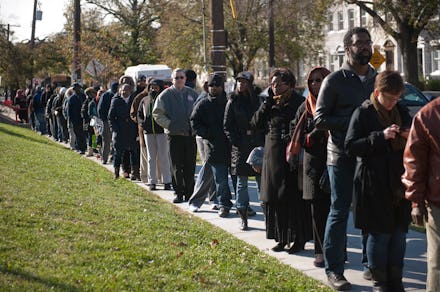Minority Voters Face Even More Hurdles on Election Day, but Not for the Reason You Think

Election Day is a racially fraught affair.
Since 2010, the Republican-fueled wave of policies that hamper the ease with which citizens can vote — new voter ID requirements, rollbacks of early voting and restriction of convenient registration — has made it harder for minority voters, who skew Democratic, to cast their ballot.
But entirely separate from this agenda is one less-well-known factor that also discourages voting, research shows. Minority voters have to wait longer to cast their ballots, and this phenomenon diminishes turnout.
Race matters when it comes to voting: In 2012, black voters waited twice as long in line as white voters. Black people waited 23 minutes, Hispanics waited 19 minutes, and whites 12 minutes. White people who lived in areas where the population was less than 5% minority had the shortest wait time of 7 minutes.
This chart from Mother Jones shows the wide disparity between wait times on Election Day:
Some areas had extremely long wait times for minority voters. Mother Jones reports that in South Carolina's Richland County, which is 48% black, many faced a wait time of 5 hours or longer. There is no doubt that people shared stories of waiting in line and changed the odds that others in the area decided it wasn't worth the effort to come out.
An Orlando Sentinel analysis found that most of the worst lines that had many Floridians waiting for several hours to vote were counties with high Hispanic populations. This kind of thing is not without consequence. The analysis found that 200,000 people were dissuaded by the long lines, and a majority of those votes would have gone to President Obama.
This isn't the result of Republican machinations: Unlike the GOP's vote-restriction campaign, the correspondence between race and wait time in these studies isn't the demonstrable product of cynical maneuvering. There are different variables in different locations, but broadly speaking, voting-related services tend to be worse in areas with higher minority populations.
A Brennan Center for Justice report on long lines in select states in 2012 found that voters in precincts with higher percentages of minority voters tended to have fewer machines and poll workers. In Maryland, for example, the 10 precincts with the lowest number of machines per voter had, on average, over twice the percentage of Hispanic voting age citizens as the statewide average.
So why is this happening? A number of observers rely on Charles Stewart III's explanation: Poor voting-related services are simply part of the general problem of worse public services in areas with greater concentrations of minorities. Just as there's a correlation between race and access to education or healthy food, so it is with being able to vote conveniently and efficiently.
This is fixable: The good news is that most research suggests this is relatively easy to fix. States should pay extra attention to precincts with higher minority populations and correct imbalances in voting-related resources. Often this just means enforcing existing standards that are being neglected on the local level. That will take us one step closer to a democracy that reflects us all.